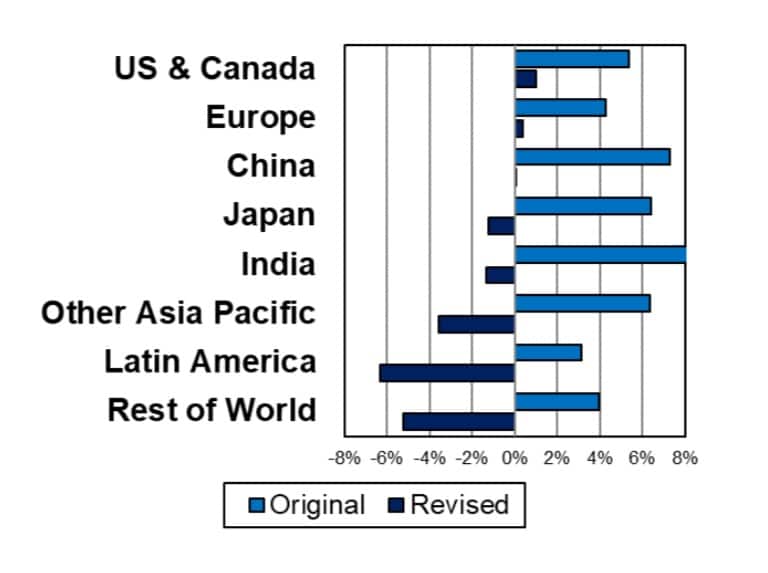Declining Markets Amid Pandemic, But Some Bright Points Found
The world has changed in ways that would have been difficult to imaging just five months ago, when SDi released its flagship Global Assessment Report in February 2020. In that time, COVID-19 has dominated our lives, leaving no one untouched health wise, economically, or socially. For most involved in laboratory research and development, the first half of the year has been characterized by laboratory shut downs or significantly reduced activity. While laboratory activities are gradually resuming in most regions, any steps forward are threatened by new surges of infection, leading to the possibility of reimposed restrictions.
To reflect the new realities of the analytical instrumentation market during this unprecedented pandemic situation and in the subsequent pandemic-driven recession, SDi has released a completely revised edition of its Global Assessment Report. The report examines the markets for 83 categories of analytical and life science instrumentation, providing data for overall market size, a five-year growth forecast, vendor share, and segmentation by product type, region, end user, and application. While SDi’s original forecast anticipated overall market growth of 5.4% in 2020, the revised edition downgrades this outlook to a decline of 0.2%. Revised forecasts provide insights into how the markets for each product are expected to weather the uncertainty of the next five years.
Of course, looking at the market as a whole provides a very narrow view of an extremely diverse set of technologies, which are being very differently impacted by the pandemic. Consequently, individual techniques will experience changes ranging from double-digit decline to double-digit growth in demand.
Life science instrumentation techniques and associated sample preparation techniques are a safe harbor in the pandemic storm; most life science techniques are projected to experience only mild declines in demand, while the several technologies that are directly involved in COVID-19 diagnostics are like shinning beacons in the storm, experiencing skyrocketing demand. Taken together, the overall life science market will see mid-single digit growth. In fact, the life science segment alone is serving as a buoy for the entire analytical instrumentation market, allowing the market to float with flat growth rather than sinking into the depths like so many other industries.
Diagnostic testing is vital in tracking and fighting the spread of COVID-19. In the early months of the pandemic, the shortage of diagnostic testing in most regions was a major headline in the news. Specifically, limited supply of RNA sample preparation created a bottleneck, forcing suppliers to scramble to increase production capacity. This exponential growth in demand is far offsetting lowered demand for other types of nucleic acid preparation, including DNA extraction, and will drive double-digit growth for the entire NA prep market. Once patient samples are prepared, active infection by the virus is detected via PCR, driving double-digit growth for 2020. Multiplex high-throughput ELISA technologies are used to conduct antibody testing, to detect the presence of antibodies which would indicate past exposure to the SARS-CoV-2 virus. Demand for antibody testing is rapidly growing, as people are interested in finding out whether they have already been infected with a mild or asymptomatic case of the illness and may have immunity. It, too, is projected to experience double-digit growth in 2020. Elevated demand for NA prep, PCR, and high-throughput ELISA will continue to accelerate as testing rates increase amid growing infection rates in many regions.
On the research and development side of the pandemic, many other life science techniques are contributing the understanding and developing treatments and vaccines against COVID-19. However, these techniques will not see the extreme elevation in demand enjoyed by those used in clinical diagnostics. Demand generated by COVID-19 research will be offset by declines from other research areas, as most non-COVID related research has suffered disruptions during the pandemic. Sequencing, for instance, is a tool being widely employed in R&D against the virus. Sequencing of the RNA-based viral genome provides a clearer understand the virus, and targetable markers may be revealed in the genome. However, with the extended closure or limited accessibility of labs in other areas of research, demand growth for sequencing will be slower than recent years.
Demand for life science technologies are the bright spot in a very uncertain market. If growth for these technologies can be used as a proxy for the global effort being put forth to beat COVID-19, we should be optimistic that we will emerge from this pandemic with a body of knowledge and new therapeutic modalities which will better equip us to face future challenges.




